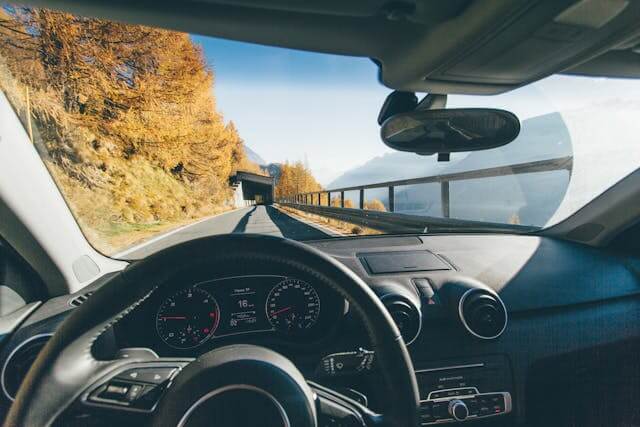Table of Contents
Car and Driving Terms in German
- der Airbag (the airbag)
- das Auto (the car)
- die Autobahn (the highway)
- das Automatikgetriebe (the automatic transmission)
- der Blinker (the turn signal / indicator)
- die Bremse (the brake)
- das Elektroauto (the electric car)
- die Fahrprüfung (the driving test)
- die Fahrspur (the lane)
- das Gaspedal (the accelerator)
- die Geschwindigkeitsbegrenzung (the speed limit)
- die Handbremse (the handbrake)
- die Hupe (the horn)
- der Kraftstoff (the fuel)
- das Kupplungspedal (the clutch pedal)
- das Lenkrad (the steering wheel)
- das Nummernschild (the license plate)
- das Schaltgetriebe (the manual transmission)
- der Sicherheitsgurt (the seatbelt)
- der Stau (the traffic jam)
- die Tankstelle (the gas station)
- der Unfall (the accident)
- das Verkehrszeichen (the traffic sign)
- die Vorfahrt (the right of way)
- der Wagen (the vehicle / car)

Real-World Driving Example Sentences
| German Word | German Sentence | English Translation |
|---|---|---|
| der Airbag | Der Airbag schützt den Fahrer bei einem Unfall. | The airbag protects the driver during an accident. |
| das Auto | Ich fahre jeden Tag mit dem Auto zur Arbeit. | I drive to work by car every day. |
| die Autobahn | Auf der Autobahn darf man oft schneller fahren. | You can often drive faster on the highway. |
| das Automatikgetriebe | Mein neues Auto hat ein Automatikgetriebe. | My new car has an automatic transmission. |
| der Blinker | Setze immer rechtzeitig den Blinker beim Abbiegen. | Always use your turn signal in time when turning. |
| die Bremse | Ich trete die Bremse, um zu stoppen. | I press the brake to stop. |
| das Elektroauto | Sie hat sich ein Elektroauto gekauft, um umweltfreundlich zu fahren. | She bought an electric car to drive more eco-friendly. |
| die Fahrprüfung | Ich habe meine Fahrprüfung beim zweiten Versuch bestanden. | I passed my driving test on the second try. |
| die Fahrspur | Wechsle die Fahrspur nur, wenn es sicher ist. | Change lanes only when it is safe. |
| das Gaspedal | Drücke das Gaspedal vorsichtig, um gleichmäßig zu beschleunigen. | Press the accelerator carefully for smooth acceleration. |
| die Geschwindigkeitsbegrenzung | Die Geschwindigkeitsbegrenzung ist hier 50 km/h. | The speed limit is 50 km/h here. |
| die Handbremse | Vergiss nicht, die Handbremse vor der Fahrt zu lösen. | Don’t forget to release the handbrake before driving. |
| die Hupe | Nutzt die Hupe nur in Gefahrensituationen. | Use the horn only in dangerous situations. |
| der Kraftstoff | Der Kraftstoff wird immer teurer. | Fuel is getting more expensive. |
| das Kupplungspedal | Du musst das Kupplungspedal durchdrücken, um zu schalten. | You must press the clutch pedal down to shift gears. |
| das Lenkrad | Halte das Lenkrad immer mit beiden Händen. | Always hold the steering wheel with both hands. |
| das Nummernschild | Das Nummernschild zeigt das Kennzeichen meines Autos. | The license plate shows my car’s registration. |
| das Schaltgetriebe | Viele Fahrer bevorzugen ein Schaltgetriebe. | Many drivers prefer a manual transmission. |
| der Sicherheitsgurt | Bitte legen Sie den Sicherheitsgurt an. | Please fasten your seatbelt. |
| der Stau | Auf dem Weg zur Arbeit stehe ich oft im Stau. | I often sit in a traffic jam on the way to work. |
| die Tankstelle | Ich halte an der Tankstelle, um zu tanken. | I stop at the gas station to refuel. |
| der Unfall | Nach dem Unfall musste die Polizei den Verkehr regeln. | After the accident, the police had to direct traffic. |
| das Verkehrszeichen | Das Verkehrszeichen warnt vor einer scharfen Kurve. | The traffic sign warns of a sharp curve. |
| die Vorfahrt | Hier hat der Gegenverkehr Vorfahrt. | On this road, oncoming traffic has the right of way. |
| der Wagen | Mein Wagen ist schon zehn Jahre alt. | My vehicle is already ten years old. |
Conclusion
These car and driving terms will help you discuss German traffic situations at the B2-C1 level. Review the examples and try using them during conversations or when reading German road signs. Consistent practice will improve your language skills and confidence on the road.
Frequently Asked Questions
Why should I learn German car and driving vocabulary?
Learning car and driving vocabulary helps you understand traffic signs, driving instructions, and conversations about vehicles. It is especially useful if you live, work, or travel in a German-speaking country.
Is this vocabulary list useful for the driving test in Germany?
Yes. Some of these words appear in written or spoken parts of the Führerscheinprüfung (driving test). Terms like Vorfahrt (right of way), Verkehrszeichen (traffic sign), and Fahrprüfung (driving test) are essential for preparation.
What level of German is this vocabulary for?
This list is suitable for B2 to C1 learners.
Can I use these words in conversation?
Absolutely. These terms are common in conversations about traffic, car repairs, navigation, and road safety. You’ll hear them at the gas station, during driving lessons, or when discussing cars with friends.
Where can I find more vocabulary for real-life situations?
Check out our complete collection of German vocabulary articles. We cover topics like banking, healthcare, work, travel, and daily life.

